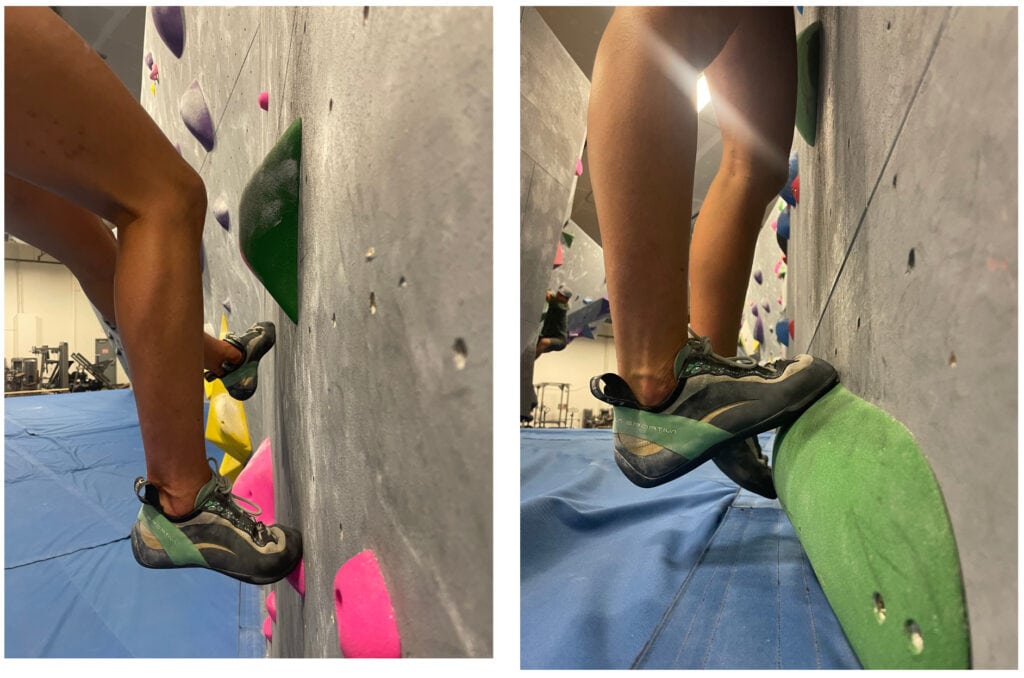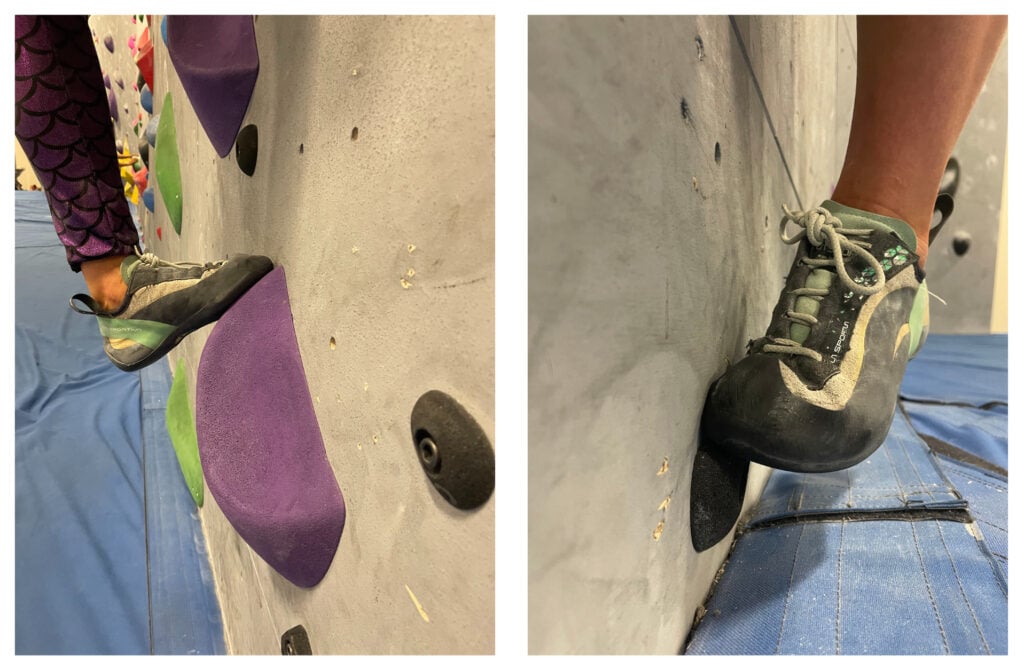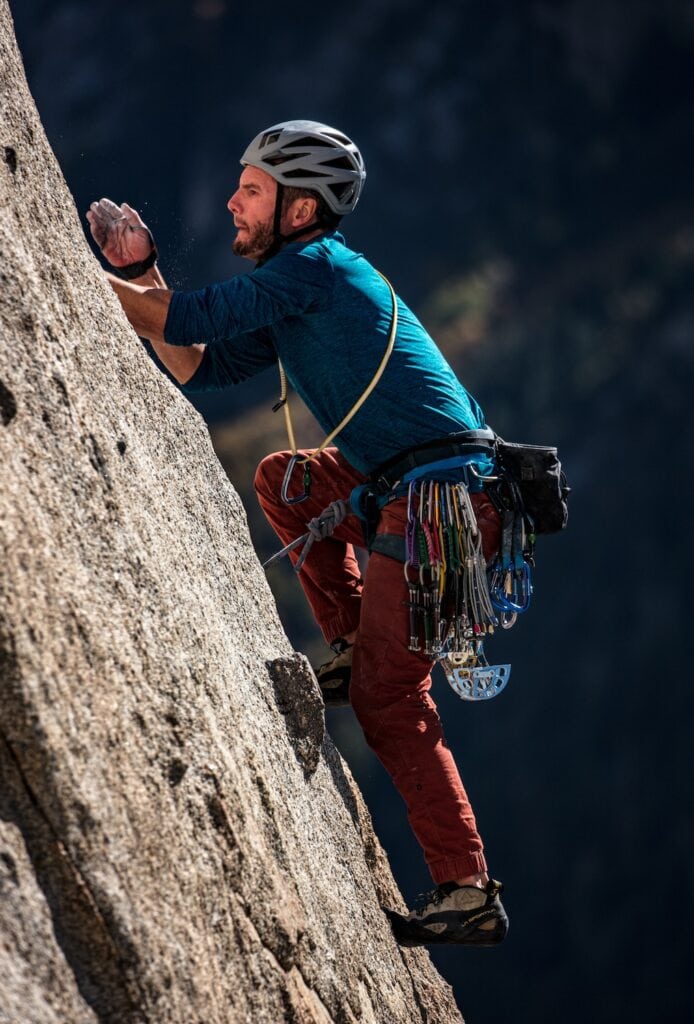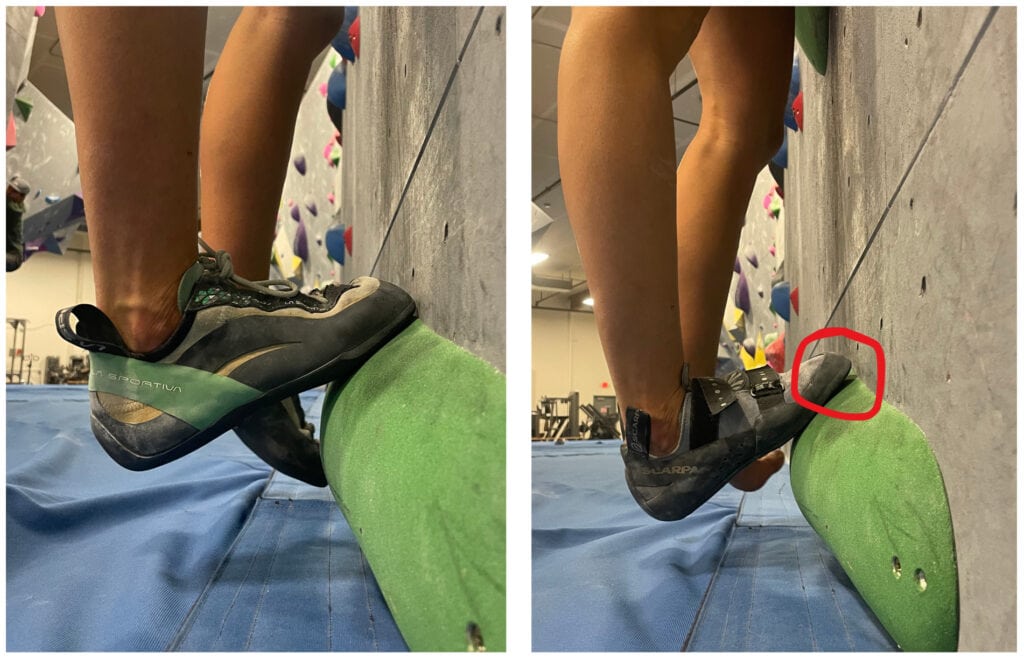Smearing Climbing Technique: How to Get Better (2024 Guide)
Published on: 08/05/2023
“Take!” I yelled down to my belayer, and sat back on the rope.
I looked up at the ten feet of rock that lay between me and the anchors. Nothing, I thought, shaking my head. The flakes and patinas with which I had confidently pulled my body up had disappeared. The rock above me was less than vertical, but I saw absolutely no holds.
I gave the top of the climb a couple of tries: I would stand up, attempt to step up the wall, and fall. Eventually, I came down, puzzled. The climb was well within my grade range, but I had no idea how to do it.
What was I missing?
I didn’t know it at the time, but what I was missing was the knowledge of smearing.
What Is Smearing in Climbing?
Smearing is a rock climbing technique that involves using a smooth, featureless portion of the wall as a foothold. Basically, to smear, you place your foot onto the rock (a dish or dip is helpful here), drop your heel, and press your body weight into your foot. This will allow you to stand up on what just moments before appeared to be a blank rock face!
The amount of smearing you will do as a rock climber depends heavily on the style you like to climb. This technique is most often utilized on slabs where the angle of the wall is less than vertical. It’s more common to smear when climbing outdoors, but some indoor climbs require the climber to utilize this technique on volumes or rounded footholds.

If you’re a trad climber, knowing this technique will definitely come in handy– many trad routes involve sections of slab climbing or necessitate technical footwork. In contrast, if pumpy, overhung sport routes are your go-to, you may not smear all that often. Even if that sounds like you, this is a technique that all climbers should know. Inevitably, we all will encounter sections of rock with no obvious footholds.
Smearing is highly friction dependent, so you may notice that this technique is easier to execute when temperatures are colder or the rock is in the shade. The type of rock also affects this: rock types such as sandstone and granite tend to have more friction, making it easier for your foot to stick. In contrast, slipperier rock types such as gneiss may make smearing more challenging.
Smearing vs edging
Smearing and edging are the two most common footwork types in rock climbing. At the beginning of your climbing career, you probably spend most of your time edging: placing your feet on little edges or features in the rock. When these features exist, it’s usually easier to use them. But when the edges run out, smearing becomes a necessity.
Heel position
The techniques you use to smear vs. edge are quite different, so it’s important to be cognizant of which technique you’re doing to execute it well. One of the major differences is in regards to foot position: when you edge, you want your heel to be up, whereas when you smear, you want your heels low to get more of your shoe in contact with the rock.

You’ll also need to consider how your feet are oriented. When edging, it’s common to position your foot somewhat parallel to the wall, so the side of your climbing shoe can make contact with the hold. If you try to edge with your shoe perpendicular to the wall, the only point of contact will be the very tip of your climbing shoe, which is unstable.
The opposite is true when smearing: your foot placements should be relatively perpendicular to the wall. This maximizes the surface area of your shoe that is touching the rock to create friction, thus helping with maintaining balance.

Hips position
Your body position also changes when you smear. You may have heard the common climbing advice to keep your hips close to the wall. This is good advice when edging, as it helps keep your weight on your feet and lessens the strain on your upper body.
But when you smear, you should actually lean back slightly. This helps you maintain balance on the sloping surface that your feet are resting on. Think about creating a triangle with your body, with your hips slightly out and your arms straight. It may seem counterintuitive at first, but this body position will provide better balance and should feel secure with some practice.

Right: smearing with poor body position, heels up, and hips close to the wall.
How to Get Better at Smearing
The foundations of good smearing are having your heels low and pushing your hips away from the wall. But what can you do to take your smearing from good enough to incredible?
Foot placement
One important consideration is where to place your feet. Many newer climbers struggle with this, as they might be used to gym climbs where the feet are clearly marked. When faced with an expanse of blank rock or a large volume, it can be difficult to know where to place the big toe in order to have a solid smear.
The most important thing to look for is indentations on the rock. Think about it this way: you want to smear on the lowest angle rock you can. You can imagine that smearing on a vertical wall would be much tougher than smearing on a horizontal piece of rock — that’s really just standing.
So the lower angle the rock is, the more like standing it is. Try to have precise foot placement and look for the lowest angle spot you can find. Another strategy you can employ is to spot where other people have put their feet by looking for black rubber left behind by climbing shoes (chalk marks can also work).
Making small steps
One of the common smearing mistakes that many rock climbers make is to move their feet too high. It’s best to make small controlled movements up the wall as opposed to aiming for a big step to a high foot. Since smearing depends heavily on balance, controlled motions give you the best chance of staying on the rock.
Trusting your feet
One of the most challenging parts about smearing can be the mental component. Using sloping rock as a foothold can feel insecure, and many people are scared of slipping or falling.
But this is one of the most important strategies for good smearing: if you trust your feet and press into them, they’re more likely to stay put and you will gain confidence. So even if it feels a bit counterintuitive, concentrate on pushing in with the balls of your feet.

Smearing Drills
If you’re looking to up your smearing technique, try one of these drills!
1. No hands climbing
A great way to practice smearing effectively is to eliminate your hands entirely! To do this drill, you’ll need a slab wall with relatively easy climbs. This could be a boulder or a top rope wall — lead climbing with no hands is probably not the best idea.
The drill is simple: climb with no hands! You’ll have to focus on stepping up with your leg muscles, maintaining your balance, and of course, smearing. If it feels impossible to climb with no hands at all, try keeping your hands in fists, so that you can use them to press against holds, but you can’t actually grab anything.
2. Foothold eliminates
An easy way to increase the need for smearing in the gym is by eliminating some or all of the set footholds, and instead smearing against the actual wall. This is another drill that’s best done on either boulders or a toprope.
Pick a climb that’s relatively easy for you and use the set handholds, but smear against the wall with your feet! If this is too hard, you can try using a regular foothold with one foot and smearing with the other. Play around and find what works for your level.
3. Smear poorly (on purpose)
Sometimes the best way to learn to do something right is to do it wrong. Find a slab climb with some sloping footholds, and smear as badly as you can. Keep your heels up, place your foot parallel to the wall, and keep your hips glued to the wall.
See how this feels, then fix your mistakes! Use the best technique you can, and you’ll be able to feel the difference that knowing how to smear can make.
What Climbing Shoes Are Best for Smearing?
Smearing is a climbing technique for which what you have on your feet really matters.
The importance of the rubber sole
When you’re primarily edging, you want a stiffer shoe with sharp edges. This is because you’re relying on either the outside or inside edge of your shoe. But when smearing is your focus, you want softer shoes since you want the shoe rubber to make as much surface contact with the rock as possible to get enough friction.

Flat versus downturned shoe
The downturned shoes you often see people bouldering in won’t help you much for smearing — try a flatter model so the shoe’s rubber can better conform to the shape of the rock surface. Downturned shoes are most useful for steeper routes and overhanging terrain, where the hooked shape can help your feet grab holds when your body is no longer vertical. But for everything else, you might be surprised how well a flat shoe can do.
No Edge shoes
If you want a great shoe for smearing, consider the new No Edge shoes from La Sportiva. These shoes are designed for technical footwork, and the soft rubber they are made of means they can easily maximize the surface area of rubber on each foothold. The major draw of the No Edge shoes is that they are extremely sensitive — you can feel the texture of the rock through the shoe. Many climbers find this level of sensitivity helpful when practicing smearing.
Wrapping Up
After reading this article, you should have a good understanding of how smearing works and when to use it. Remember to drop your heel, push your hips out, and look for ways to maximize contact between your foot and the wall.
Smearing well will help you up your climbing game, especially on slab climbs or technical faces. But it’s not the only technique you’ll need in these situations — understanding how to edge well will aid your footwork too. And on other types of climbs, mastering climbing techniques such as toe and heel hooking is essential.
Note: all photos © Wren Cilimburg unless indicated otherwise.
